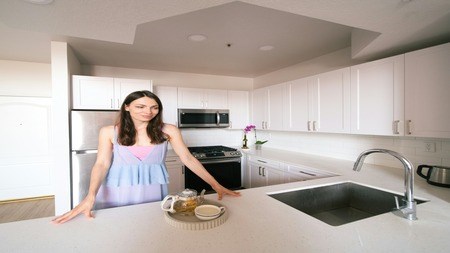Why do people downsize?
It’s a question often influenced by market conditions and economic shifts. Downsizing is no longer just the domain of those approaching retirement or empty nesters.
It’s also a lifestyle choice,” says Kim Woods, franchisee of Tyson Properties’ Morningside Durban office. “Many people are choosing smaller dwellings over larger properties, intentionally deciding to sacrifice living space for a more affordable or improved lifestyle that allows them to devote more time and money to the things they love.
Downsizing presents an opportunity to reset your lifestyle and surround yourself only with the things you truly love and need.
Cynthia Mabela, owner of Eyezwe Interiors and interior designer, points out that downsizing can actually mean upgrading to a more refined way of living: A better term for downsizing is ‘rightsizing’—which is more about finding a home that suits your needs and lifestyle, resulting in a better quality of life.
Mabela emphasises that rightsizing is an opportunity to live more minimally with the items you treasure, to declutter, and even to upgrade your surroundings with stylish interiors and thoughtful choices that make your home more meaningful to you than just its asset value. And the best part is that this has innumerable benefits beyond financial ones.
The lifestyle question: How do you want to live?
Form and function in the design of your home are key,” says Mabela. “For example, there’s no point in having a big kitchen if you don’t regularly entertain a large number of guests.

Similarly, is there any reason to keep a massive lounge suite if it restricts your space or makes the room feel cramped?

Ask yourself:
What moments in my day do I value most — and does my space support them? (E.g. Do you love quiet mornings with coffee and a book? Are you energized by having friends over? Does your layout make those moments easier or harder?)
Which spaces in my current home feel good — and which ones stress me out? (Reflect on where you actually spend time. If there are rooms you avoid, why? If some corners feel peaceful, what makes them work?)
Am I designing for the life I had — or the life I want now? (Let go of old furniture, layouts, or “just in case” items that no longer fit the lifestyle you're building.)
Relationship with space
Your relationship with space changes when you move to a smaller home — every square metre needs to serve a purpose. Think about how rooms connect, how you move through your home, and how each area makes you feel. Is your furniture blocking natural light? Are your walkways tight or open? These details affect how your space functions and how comfortable it feels.
“You don’t just decorate a smaller space — you design it intentionally,” says Mabela. “Start by identifying which rooms you use daily and which ones you can let go of. For example, can a guest bedroom double as a home office? Does your dining room table need to seat eight if you only host large dinners twice a year?”
Use layout tools or apps to experiment with floor plans. Focus on zoning — even in open-plan spaces — to create clear areas for relaxing, eating, working, or entertaining. Consider investing in modular furniture or pieces on wheels to keep your layout flexible as your needs change.
Preparing to downsize
Whether you’re moving to a smaller property or repurposing an existing one, key decisions need to be made about how you’ll use the space.
Mabela suggests visualising how each area will function:
- Will your current furniture work in each room?
- What do you need to create a spacious yet comfortable home?
This will help you decide what furniture to keep and where it will be placed.
Planning makes this process easier. Sketch out the layout of your new home, noting where you’ll position furniture and decor—like mirrors and artwork—to help you get excited about the move.
Mabela’s top tips:
Choose multifunctional furniture that includes storage.
Consider reupholstering or resizing existing pieces to give them a fresh look.
Maximise vertical storage with shelves and tall cabinets.
Use decorative boxes and baskets for a styled yet functional aesthetic.
Look into under-bed storage or ottomans for hidden storage options.
Choose paint colours wisely. A single colour throughout can make a small space feel bigger, while soft furnishings can create variety between rooms.
Ensure easy access to frequently used items.
Carefully position artwork and decor where you’ll enjoy them for the long term.

Cutting the clutter
Not everything you own will fit into your new space—and that’s okay. You might need to invest in smaller furniture and part ways with items you’re emotionally attached to.
This can be a healthy exercise, allowing you to let go of what’s familiar in exchange for an improved quality of life,” says Mabela.
Give yourself as much time as possible to go through each item before packing, so you’re well-prepared for the move. Don’t take clutter with you—storage may be limited.

Ask yourself:
Do I need this, and will I use it in my new property?
Do I love this, and can I find a place for it in my new home?
Could this be sold, donated, or repurposed?
Would a friend or family member appreciate this more?
Should I replace this with a smaller version?
Creating a brighter future
Change can feel overwhelming, but downsizing doesn’t have to be daunting. With careful planning, intentional design choices, and a clear vision of your ideal lifestyle, the move to a smaller home can become a rewarding journey.
Whether you’re embracing minimalism, prioritising quality over quantity, or seeking a more manageable and cost-effective way of living, this transition is a chance to realign your home with your current values and future goals. “Rightsizing is really about stepping into the next chapter of your life with clarity and purpose,” says Woods. “It’s not about giving up space—it’s about gaining freedom.”
Use this move to reset, refresh, and create a home that supports how you truly want to live—comfortably, consciously, and clutter-free.




